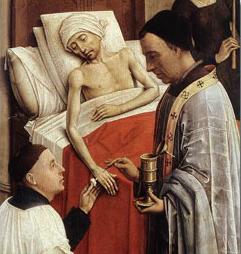Clergy "secret" revealed
Recently I shared a story of my son who was "mortally wounded" by melted chocolate to talk about the power of rituals. There is even science supporting the power of rituals.
When I clergy go into a hospital setting, there is an unspoken ritual that takes place and what I have come to discover is that ritual is generally to quick to be meaningful for most people. Here is the ritual:
Greeting - physical contact with the sick - talk with people present - pray - leave
The only thing that separates a clergy visit from a visit from the doctor is a prayer at the end. It is as though prayer is an exit strategy for us or a way to put a Jesus shine on the visit. Clergy leave but people are left behind in the cold hospital room, waiting.
If it is true that the number of steps in the ritual matter, might I suggest all of us the way Jesus preformed rituals. Now we may not have healing powers, but look at the ritual Jesus does on John 9, verse bracketed for reference:
Addressed the crowd/ill [3], stated why he was preforming a ritual [4-5], used an external tool/element [6] and touched the sick [6], and gave a directive [7]
Could it be that this would be a better ritual for hospital visits? Maybe this is why it would be worth Protestants considering to draw from our lost tradition but not forgotten by our Catholic sisters/brothers - anointing.
Address the room - Hello my name is ______, Peace be with you.
State why you are preforming a ritual - In the tradition of the Church, I would like to anoint your head with oil so that you may know even when I have left that God is always with you and that you are never alone.
Use external tool - in this case, oil
Touch the sick - mark a sign of the cross on forehead
Give directive - "Christ is with you, this day and every day. You never walk alone. From this moment on may you remember that you are a beloved child of God and a valued member of this world. Remember that you are of great worth and that your life has touched the lives of many. Remember who you are and who's you are. Amen."
Pray.
I have now done this ritual in hospital settings about twenty times. With a variety of people in different settings, but the response has been overwhelmingly meaningful. Generally a thank you follows the standard ritual, but this ancient ritual has brought tears, smiles, thanksgiving, recommitting to God, hugs and holy kisses.
And so, while this may not be something everyone feels comfortable doing, just like I do not feel comfortable putting an IV into someone's arm, I would commend clergy to consider the rituals we create and preform in the hospital setting.
Let us do a better job at showing the peace of God, the love of Christ and healing of Christ in a place that often times desperately needs it.
